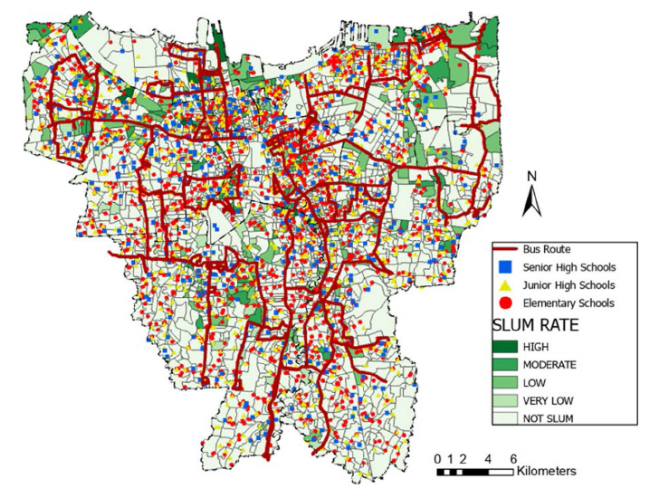
SMART CITY Universitas Indonesia is a research center that promotes multi-disciplinary perspective on studies. It encourages its researchers to have and conduct broad cross-disciplinary research topics that intersect with, but are not limited to, its major focus areas: 1) Energy & Environment, 2) Infrastructure, 3) Information & Communications Technology and Mobility, and 4) Quality of Life.
Researchers at SMART CITY in collaboration with Faculty of Engineering Universitas Indonesia: Ahmad Aki Muhaimin, Widya Laksmi Larasati, Ahmad Gamal, and Michelle Setianto, conducted research focusing on the topic of spatial justice in school distribution in Jakarta, Indonesia. This research departs from the idea of the importance of school distribution for the accessibility and fairness of provided education. It does not attempt to dwell on the issue of capacity based on the number of demands and available schools, but rather on the fair and equitable allocation of educational resources in terms of geographic location. It is believed that schools should be accessible to all members of society without exception.
This research focuses on he school distribution in the capital city of Indonesia, Jakarta. As in 2020, it has about 3899 primary and secondary schools available for over 1 million school-age children. There are two methods are used in this research. Radius and road network are used in addition to spatial analysis to measure the students’ walking accessibility level related to the school zoning system regulations in Indonesia. The analysis found the variations in accuracy between the two methods, the coverage area between formal and informal settlements, and the spatial context of the accessibility.
The finding describes that the distribution of schools and related resources can have a significant impact on students’ educational opportunities and outcomes. Implementing policies that promote equal access to resources and selecting school locations that meet students’ needs in different settings can ensure accessibility to a quality education. To this, it is important to consider the spatial justice of school distribution. This research offers a comprehensive spatial analysis that can provide and support policymakers in future planning works and implementations.
This article has been submitted and recently accepted and published on Heliyon in 2022.??
?
|
The citation :? |
Muhaimin, A. A., Gamal, A., Setianto, M. A., & Larasati, W. L. (2022). The spatial justice of school distribution in Jakarta.?Heliyon,?8(11), e11369. |
|
Keywords :? |
Spatial distribution, School, GIS, Accessibility, Equity? |
?
